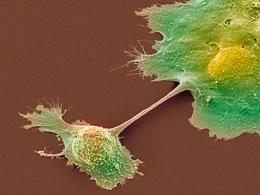Published online 24 March 2011 | Nature | doi:10.1038/news.2011.186
News
New lead on deadly pancreatic cancer
Mouse model reveals mechanism of potential therapy for lethal tumours.
 A clinical trial run in both mice and humans has examined a new way to attack pancreatic cancer.STEVE GSCHMEISSNER / SCIENCE PHOTO LIBRARY
A clinical trial run in both mice and humans has examined a new way to attack pancreatic cancer.STEVE GSCHMEISSNER / SCIENCE PHOTO LIBRARYThere are currently no effective weapons against pancreatic ductal adenocarcinoma, for which death usually follows diagnosis by just months.
But scientists have stumbled across an unexpected way to break through the cancer's formidable defences in clinical trials involving humans and, unusually, mice. Their results are published today inScience1.
Robert Vonderheide, an immunologist at the University of Pennsylvania's Abramson Cancer Center in Philadelphia, and his team activated immune cells that chewed holes in the protective shell, or stroma, that the pancreatic cancer builds around itself, and attacked the tumour cells.
Surprisingly, the immune cells involved were not the usual suspects — sophisticated anti-tumour T cells — but more primitive cells called macrophages.
"This opens up a fresh set of possibilities for seeking new treatments," says Terry Van Dyke, head of the Mouse Cancer Genetics Program at the National Cancer Institute in Frederick, Maryland, who was not involved in the study. "It's a clear indication that activating macrophages will be efficacious."
Breaking the barrier
It is the unusually tough stroma surrounding pancreatic ductal adenocarcinomas that is responsible for the disease's poor prognosis. Not only is it almost entirely impenetrable to drugs, but it also becomes enmeshed with white blood cells that prevent the immune system from launching its own attack on the cancer.
Others have designed molecular strategies to attack the stroma in the hope of facilitating drug access, and these are currently being tested in the clinic. But the stromal assault by Vonderheide's team occurred inadvertently.
The authors' original intention was to try to counteract the stroma's immunosuppressive actions by activating the protein CD40. This protein activates many types of immune cell, although it is best known for its ability to activate anti-tumour T cells. And it was on these that the scientists focused their attention, expecting the activated T cells to slip through the stroma and target the cancer.
They carried out a clinical trial on 21 patients with inoperable pancreatic cancer who were being treated with gemcitabine, the standard chemotherapy drug for the disease. They gave the patients additional injections of an experimental CD40-activating antibody.
On average, the 21 patients survived several weeks longer than would have been expected without the antibody treatment, and four patients exhibited temporary regression of their tumours. The authors examined biopsies from two of the shrunken tumours under the microscope and found them stuffed with macrophages but devoid of T cells.
"Even before the patient trial had finished, we realised that the therapy was looking successful, but perhaps not for the reasons we had imagined," says Vonderheide.
Antibody action
To establish the underlying mechanism, the scientists turned to mice that had been genetically engineered to develop a cancer similar to human pancreatic ductal adenocarcinoma. They were able to repeat the human trial in the animals, with a full set of controls, and subject them to more detailed and invasive examinations.
They treated one set of animals with gemcitabine and a mouse version of the CD40-activating antibody, and other sets with gemcitabine alone, antibody alone or no drugs. Tumours regressed in 30% of mice treated with the antibody — whether or not they had also received gemcitabine. "It was also a surprise to find that gemcitabine itself was not contributing much to the therapeutic effect," says Vonderheide.
The authors then took a close look at how the immune systems of the mice, and their tumours, had responded to CD40 activation.
"The antibody did actually cause T cells to be activated, but for some reason they remained in lymph nodes and didn't migrate to the tumours," says Vonderheide. Instead, they found activated macrophages swarming into tumours, he says — and also hanging around the stroma, which started to curl inwards and break down.
"This discovery could never have been made without using a mouse model of the cancer to dissect out the mechanism in detail," says Van Dyke, who recently moved to the National Cancer Institute to start a big translational medicine programme that will similarly match patient and mouse clinical trials in several cancers. Many such efforts are springing up around the world, including a large programme at Harvard in Cambridge, Massachusetts, launched with US stimulus money.
"Despite a lot of effort, only one new drug, erlotinib, has been approved by the Food and Drug Administration in the last decade for metastatic pancreatic cancer, and that only prolongs life by two weeks," says Vonderheide. "Maybe our discovery will lead to new ideas about how to manipulate the immune system for best therapeutic effect."

Nenhum comentário :
Postar um comentário